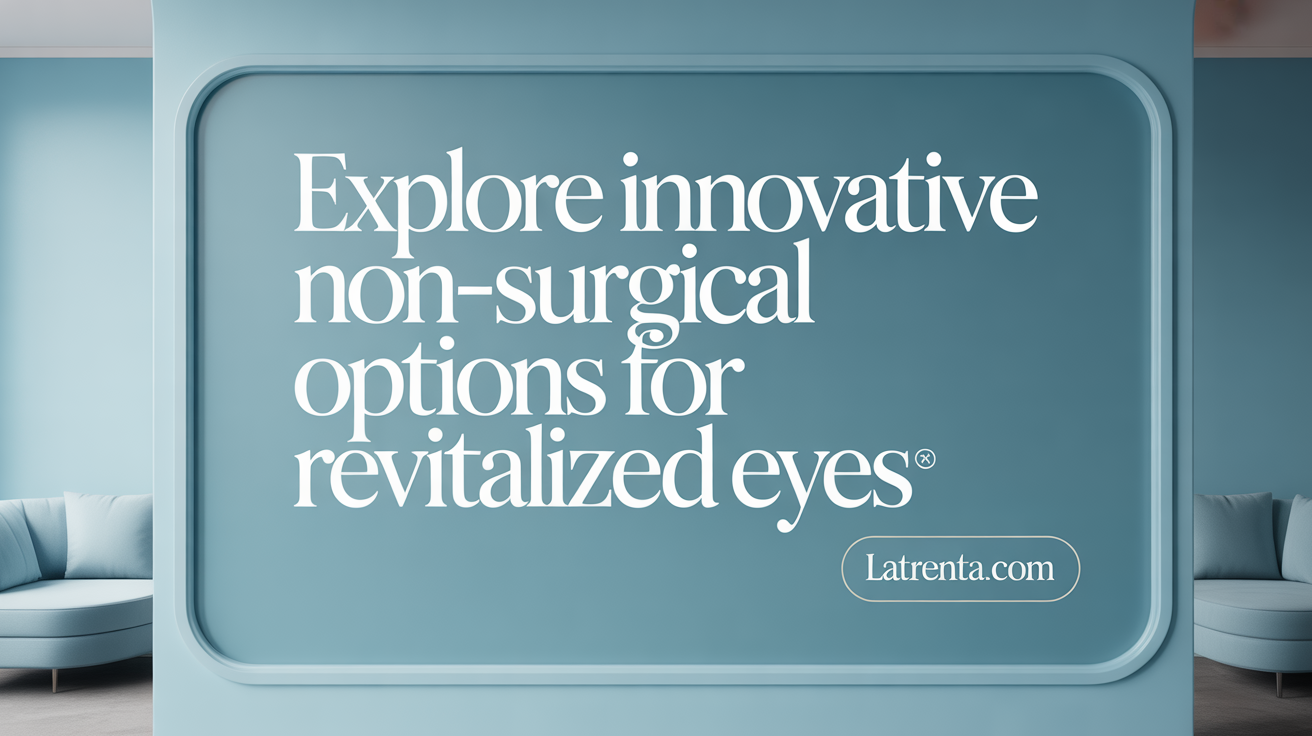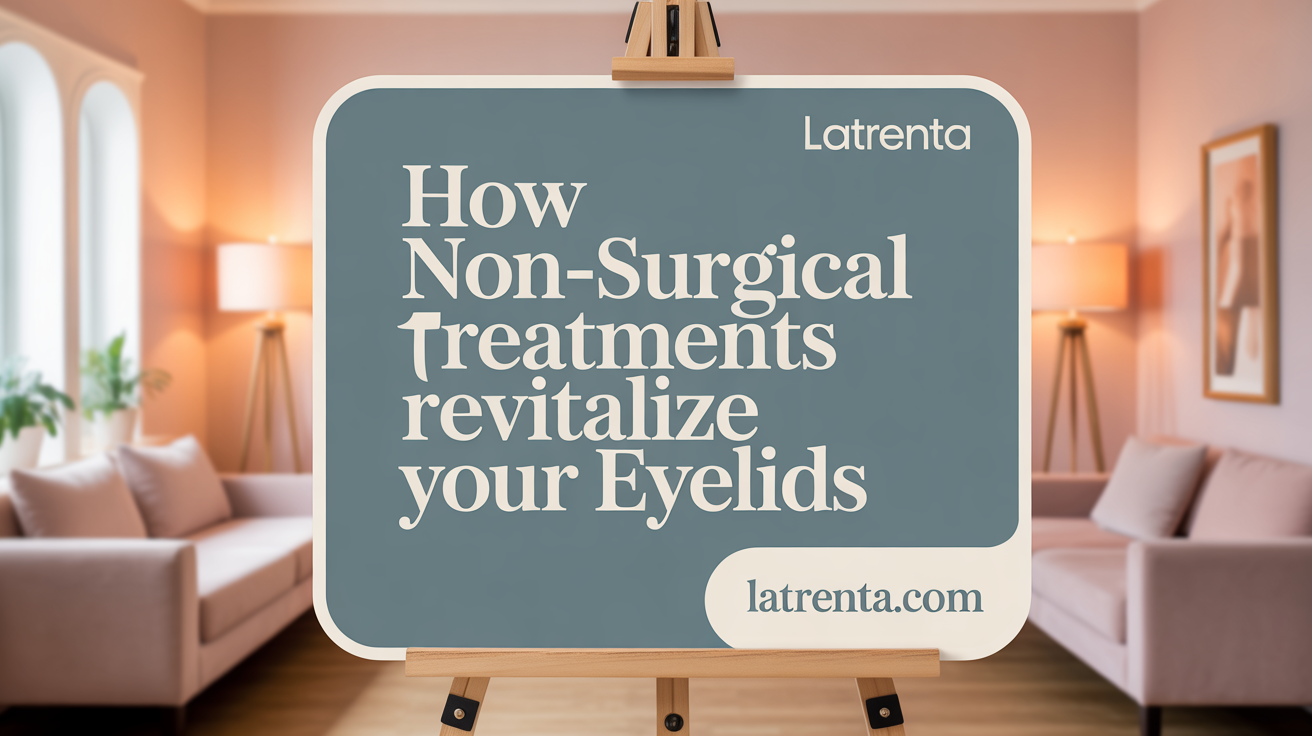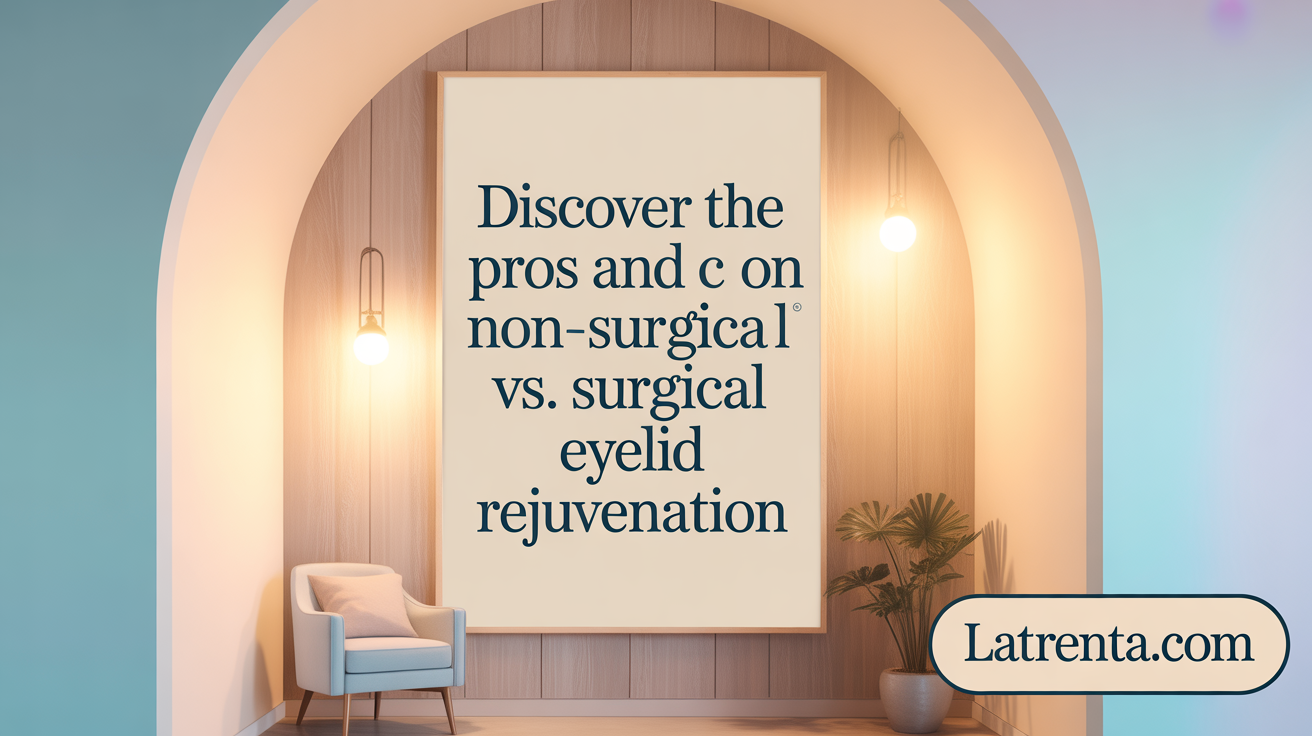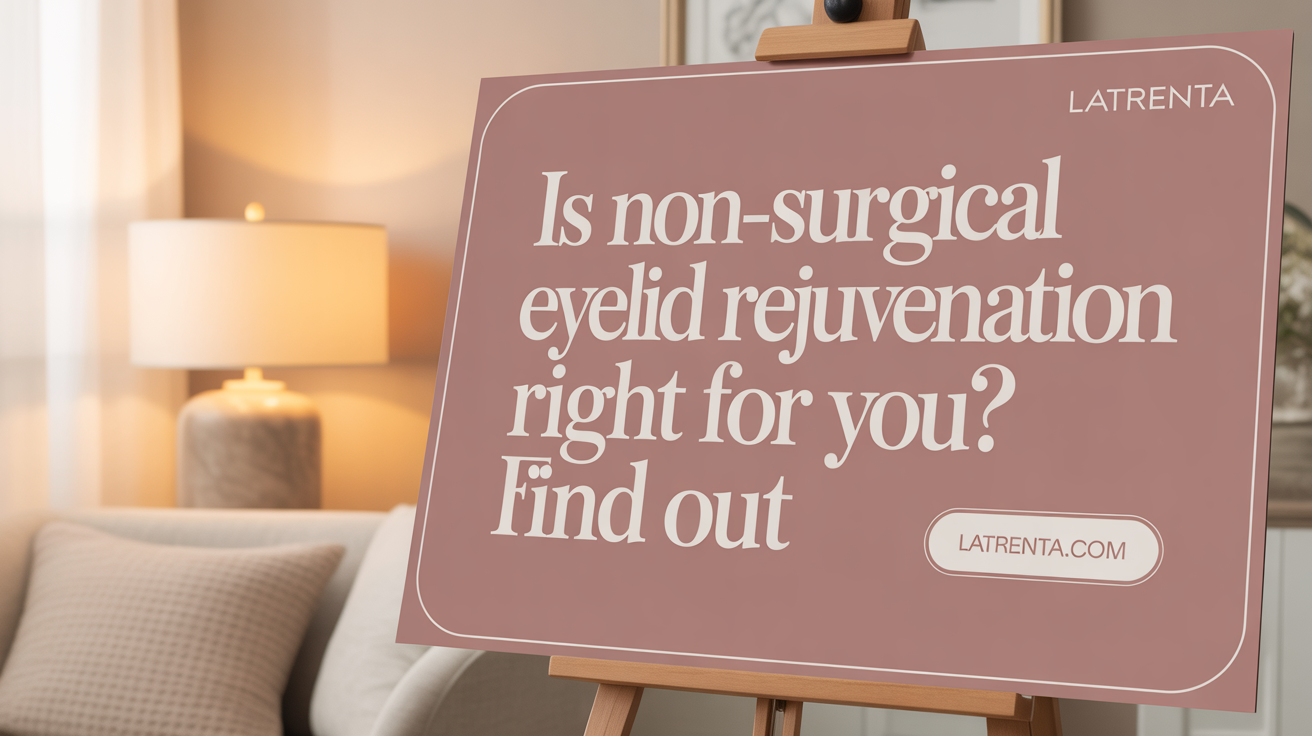Introduction to Eyelid Rejuvenation Without Surgery
Aging around the eyes manifests through sagging skin, wrinkles, volume loss, and droopy eyelids, profoundly impacting facial aesthetics and self-confidence. While surgical blepharoplasty has long been the gold standard for dramatic transformation, recent years have seen a surge in effective non-surgical alternatives. This article explores the best current options for eyelid rejuvenation without surgery, focusing on how they work, their benefits and limitations, suitability, costs, and expected outcomes to help readers make informed decisions about revitalizing their eye area safely and efficiently.
Comprehensive Overview of Non-Surgical Eyelid Rejuvenation Techniques

What non-surgical options are available for eyelid rejuvenation?
For those seeking rejuvenation of the eyelid area without undergoing surgery, there are several effective options. These minimally invasive treatments can soften lines, lift the skin, and restore volume, offering a natural appearance with little to no downtime.
Injectable treatments are among the most popular. Dermal fillers made from hyaluronic acid can fill hollows and dark circles, restoring lost volume and smoothing the transition between the eyelid and cheek. Neuromodulators like Botox or Dysport are used to relax specific muscles, reducing wrinkles and minor sagging, and can even lift hooded eyelids when injected strategically.
Skin tightening procedures include radiofrequency (RF) treatments such as Thermage and ThermaQ, which deliver controlled heat deep into the skin to stimulate collagen production, resulting in firmer, tighter skin. Laser resurfacing, whether fractional or ablative, can improve skin texture and pigmentation, promoting collagen growth for a smoother, rejuvenated eyelid skin.
Chemical peels with acids like glycolic or TCA can refine skin texture and reduce fine lines but need to be used carefully around sensitive eyelid skin. Topical creams containing retinol, vitamin C, and hyaluronic acid can hydrate the skin, improve tone, and support collagen synthesis over time.
Combining multiple treatments can optimize results. For instance, using fillers to restore volume alongside RF or laser therapy to tighten skin provides a comprehensive approach.
These procedures are ideal for individuals with mild to moderate eyelid concerns who prefer non-invasive options. It is important to consult a qualified specialist to tailor treatments to your specific needs and ensure a safe, effective rejuvenation plan.
Benefits of combining multiple treatments
When combined, these treatments can address various aspects of eyelid aging—wrinkles, volume loss, and skin laxity—leading to more noticeable and natural results. The synergy of therapies often extends the longevity of improvements, with some treatments like RF and laser stimulating ongoing collagen production. Multiple modalities also allow for customized plans based on individual skin condition, aesthetic goals, and recovery preferences.
Always seek advice from trained professionals to explore the best treatment combinations for you, ensuring safe application and optimal outcomes.
Mechanisms and Benefits of Non-Surgical Eyelid Treatments
 Non-surgical eyelid rejuvenation options work by targeting skin laxity, volume loss, and wrinkles, aiming to improve appearance with less risk and downtime compared to surgery.
Non-surgical eyelid rejuvenation options work by targeting skin laxity, volume loss, and wrinkles, aiming to improve appearance with less risk and downtime compared to surgery.
One common approach involves dermal fillers, mainly hyaluronic acid-based, which restore volume under the eyes, smooth out hollows, and reduce dark circles. By replacing lost tissue, fillers provide immediate results that typically last between 6 months and 2 years.
Neuromodulators such as Botox or Dysport relax muscles responsible for wrinkle formation. When injected around the eyes and brow area, they soften crow’s feet, lift hooded eyelids, and create a more youthful, refreshed look. Effects usually last for 3 to 6 months.
Collagen stimulation techniques like laser skin resurfacing and radiofrequency devices (e.g., Thermage or Ultherapy) induce collagen remodeling by heating the deeper layers of the skin. This process tightens skin and improves its elasticity, leading to gradual lifting and smoothing over several weeks or months.
Emerging technologies such as plasma exeresis and platelet-rich plasma (PRP) injections are gaining popularity. Plasma fibroblast treatments use high-frequency electric current to create controlled micro-injuries that stimulate collagen growth, resulting in tighter skin over 6 to 8 weeks. PRP involves injecting the patient’s own blood-derived platelets to enhance collagen and elastin production, supporting overall skin health.
The advantages of these non-surgical methods include minimal invasiveness, very little or no downtime, and relatively low risk of complications. They are suitable for mild to moderate signs of aging, such as early drooping, fine lines, or hollows, and can be performed in outpatient settings.
However, these treatments have limitations. They generally produce subtle and temporary results that require maintenance sessions. Unlike surgical eyelid lifts, they are less effective for severe sagging or excess skin. Multiple treatments are often needed to sustain improvements, and individuals with significant eyelid folds or drooping may still require surgical intervention for optimal correction.
In conclusion, non-surgical eyelid rejuvenation offers a safe and convenient alternative for those seeking subtle improvements, with the understanding that ongoing treatments are necessary to preserve the results.
Non-Surgical vs. Surgical Eyelid Rejuvenation: Key Differences

What are the differences between non-surgical and surgical eyelid rejuvenation methods?
Surgical eyelid rejuvenation, known as blepharoplasty, is a procedure that involves making precise incisions to remove or reposition excess skin, fat, and sometimes muscle around the eyelids. This approach delivers more dramatic and long-lasting results, especially effective for severe eyelid aging such as significant skin laxity, drooping, or fat protrusions.
In contrast, non-surgical methods focus on skin tightening, volume restoration, and stimulating collagen production without incisions. Treatments like laser resurfacing, dermal fillers, radiofrequency therapy, and platelet-rich plasma (PRP) involve minimal discomfort and downtime, with effects that tend to be temporary or require maintenance sessions.
Invasiveness and recovery comparison
Surgical blepharoplasty is more invasive, requiring anesthesia, and involves a recovery period that can last from several days to a few weeks. Patients may experience swelling, bruising, and temporary dry eyes.
Non-surgical options, however, are usually performed in-office and do not require anesthesia. They have little to no downtime, with most patients returning to normal activities immediately or within a day or two.
Effectiveness for severe drooping and fat prolapse
While surgical eyelid lift effectively addresses severe drooping, excess skin, and fat prolapse, non-surgical methods are better suited for mild to moderate signs of aging. For example, drooping eyelids caused by significant skin laxity typically require surgical correction, whereas subtle hooding or early sagging can sometimes improve with non-invasive treatments.
Risks and complications
Surgical procedures carry risks such as scarring, dry eyes, asymmetry, bleeding, and anesthesia-related complications. Recovery involves a period of swelling and bruising.
Non-surgical treatments are safer overall, with minimal risk of adverse effects. Common minor complications include temporary redness, swelling, or uneven results, but serious issues are rare.
Ideal candidates for each approach
Candidates suited for surgical blepharoplasty are those with severe eyelid sagging, prominent bags, or significant excess skin that impacts vision or causes significant aesthetic concern.
Potential candidates for non-surgical eyelid rejuvenation are individuals with mild to moderate signs of aging—early drooping, fine wrinkles, slight hollows, or surface skin laxity—who prefer a less invasive solution with fewer risks and quicker recovery.
Ultimately, the choice depends on the severity of eyelid issues, personal health, aesthetic goals, and preference for recovery time.
Top Non-Surgical Treatments for Eyelid Aging and Hooded Eyelids
Which non-surgical treatments are most effective for addressing eyelid aging and hooded eyelids?
Managing eyelid aging and hooded eyelids without surgery involves a variety of innovative and less invasive options. Among the most effective are botulinum toxins like Botox and Dysport. These injections work by relaxing the muscles that cause drooping and wrinkles around the eyes, providing a subtle lifting effect. Botox, in particular, can lift the eyelids temporarily and is especially suited for mild cases.
Dermal fillers also play a significant role in eyelid rejuvenation. By restoring volume to areas like the tear troughs and brow support, fillers help counteract volume loss that often accompanies aging. This can reduce the appearance of hollowed eyes and give a more refreshed look. Fillers made of hyaluronic acid provide immediate results that typically last from 6 months to 2 years, depending on the product and location.
Skin tightening procedures harness the body's natural collagen production to firm and lift the skin. Plasma fibroblast therapy, Thermage, and Ultherapy are popular choices that stimulate collagen remodeling, improving skin tone, elasticity, and overall firmness. Plasma fibroblast uses high-frequency electric currents to induce skin tightening, often visible within weeks and lasting up to three years. Thermage applies radiofrequency energy, typically resulting in a more noticeable lift after one or multiple sessions. Ultherapy employs focused ultrasound to stimulate deep collagen, leading to skin tightening with no downtime. These treatments are particularly effective for mild to moderate sagging.
Laser skin resurfacing is another advanced technique that improves skin texture, reduces fine lines, and supports collagen growth. Fractional CO2 lasers, such as Fraxel®, create microscopic skin injuries that promote healing and collagen regeneration, resulting in smoother, tighter eyelid skin over time.
Complementary minimally invasive options include eyebrow thread lifts and microcurrent devices. Thread lifts involve placing dissolvable threads in the eyebrow and eyelid area to provide instant support and lift that can last from one to three years. Microcurrent devices stimulate muscles through gentle electrical currents, lifting the skin temporarily and improving muscle tone, which can be performed at clinics or even at home.
Finally, the prescription eye drops Upneeq offer a short-term solution by temporarily elevating eyelids by about 1mm for up to 8 hours. They are convenient for quick improvements, especially when combined with other treatments for a more comprehensive approach.
In summary, effective non-surgical solutions vary based on the severity of eyelid sagging and individual goals. Combining these treatments often enhances results, offering a refreshed, natural appearance with minimal downtime. However, for pronounced eyelid drooping, surgical options like blepharoplasty remain the most durable long-term solution.
Identifying Suitable Candidates and Expected Outcomes for Non-Surgical Eyelid Rejuvenation

Who is a suitable candidate for non-surgical eyelid rejuvenation, and what outcomes can they expect?
Non-surgical eyelid rejuvenation offers a viable option for individuals experiencing mild to moderate signs of aging around the eyes. Ideal candidates typically present with fine lines, subtle skin laxity, or fat volume loss, but do not have significant sagging or prolapse of eyelid tissues that would require more invasive surgery.
People in good overall health, without underlying eye conditions, tend to benefit most from these treatments. They should also have realistic expectations, understanding that the results are usually subtle and temporary. Depending on the specific procedure—such as laser skin resurfacing, plasma fibroblast treatment, dermal fillers, Botox, RF skin tightening, or thread lifts—the effects can last anywhere from a few months to up to two years.
Commonly addressed issues include improving skin texture, reducing wrinkles, lifting mild sagging, and restoring volume or contour around the eyes. Many patients choose these options to delay or complement surgical procedures or to achieve a refreshed look with minimal downtime.
It’s important to note that individuals with more advanced eyelid sagging or significant fat protrusion are better suited for surgical eyelid surgery, known as blepharoplasty, which provides more durable and dramatic results.
Overall, non-surgical treatments serve as a gentle, less invasive approach to eyelid rejuvenation, suitable for those seeking minor corrections and who prefer avoiding the risks and recovery associated with surgery.
Biological Causes of Eyelid Aging and Their Non-Surgical Treatment Approaches
What causes eyelid aging, and how do non-surgical treatments address these causes?
Eyelid aging results from a variety of biological changes within the skin and underlying tissues. Over time, there is a natural decrease in collagen and elastin fibers, which are essential for maintaining skin firmness and elasticity. As these proteins diminish, the skin becomes looser and more prone to sagging. Additionally, fat deposits within the eyelids can shift or decrease in volume, leading to hollows and dark circles. This process often causes a tired or aged appearance.
Muscle relaxation plays a significant role in eyelid aging as muscles around the eyes weaken or become less toned, contributing to drooping and hooding of the eyelids. Changes in facial bone structure, especially in the orbital area, can also affect the overall shape and support of the eyelid tissues.
Addressing these biological causes, non-surgical treatments employ diverse mechanisms. Botulinum toxin (such as Botox or Dysport) works by relaxing the muscles responsible for wrinkles and hooding, resulting in a subtle lift and smoothing effect. Dermal fillers, mainly hyaluronic acid-based, restore volume lost due to fat displacement, filling hollows, and reducing dark circles for a more youthful look.
Laser and radiofrequency therapies stimulate collagen remodeling and encourage new elastic tissue formation, leading to skin tightening and improved texture. Plasma exeresis, PRP (platelet-rich plasma), and microneedling techniques further promote collagen and elastin production, supporting tissue firmness.
For fat-related concerns, targeted injections such as deoxycholic acid can reduce excess fat, enhancing contour and reducing puffiness. These combined approaches address the core biological issues—collagen breakdown, fat redistribution, and tissue laxity—restoring structural support and achieving natural, rejuvenated eyelids without the need for invasive surgery.
Cost, Risks, and Procedural Aspects of Non-Surgical Eyelid Rejuvenation
Non-surgical eyelid rejuvenation encompasses a variety of treatments, each with its own procedures, costs, and safety profiles. Common options include dermal fillers, Botox, laser skin resurfacing, radiofrequency therapy, Plasma Pen (plasma fibroblast), and thread lifts. These procedures are designed to lift, tighten, and improve the appearance of the eyelid area without the need for invasive surgery.
The price of these treatments generally ranges from approximately $500 to over $3,000 per session. Fillers and Botox tend to be on the lower to mid-range of this spectrum, often costing between $500 and $1,500. Laser and radiofrequency treatments can vary based on the intensity and technology used, with costs typically between $1,000 and $2,500. More specialized procedures like Plasma Pen or thread lifts may fall toward the higher end, depending on complexity and provider expertise.
Procedurally, most of these treatments are performed in outpatient clinics. They usually last from 30 minutes to 90 minutes, depending on the treatment type and extent of rejuvenation needed. For example, Botox or fillers are quick injections that offer immediate results, while laser and RF treatments may involve multiple sessions spaced weeks apart.
Side effects are generally mild and temporary. Common concerns include bruising, swelling, redness, slight discomfort, or pigmentation changes. Serious risks are rare but can include eyelid drooping, asymmetry, or infection. Proper patient assessment and a skilled practitioner are vital to minimize such risks. Candidates must be evaluated carefully to ensure they are suitable for non-surgical options.
Downtime is minimal for most treatments. Patients can usually resume normal activities immediately or after a short rest period. Post-care involves protecting the skin from sun exposure, maintaining hydration, and following specific skincare instructions provided by the clinician. Multiple sessions are often required for best results, and ongoing maintenance treatments may be necessary as the effects of certain procedures, like fillers and Botox, are temporary.
Overall, non-surgical eyelid rejuvenation offers a safe, less invasive alternative to surgery with fewer risks and less recovery time. It is especially suitable for individuals seeking subtle improvements, early signs of aging, or those unwilling to undergo anesthesia or incisions. Choosing an experienced professional is essential to ensure safety, efficacy, and natural-looking results.
Innovative Trends and Combination Strategies for Enhanced Eyelid Rejuvenation

Combining Injectables and Skin TighteningTechniques
Recent trends in eyelid rejuvenation focus on combining different non-surgical treatments to achieve natural and comprehensive results. For instance, injectables such as neuromodulators (Botox or Dysport) and dermal fillers are often paired with skin tightening procedures. Botox can lift hooded eyelids by relaxing muscles, while fillers restore volume in hollows and dark circles. When combined with skin tightening devices like Ultherapy, Thermage, or laser therapies, patients can experience a more lifted and firmed appearance.
Advances in Plasma Exeresis and Laser Technology
Emerging technologies such as plasma fibroblast therapy utilize high-frequency electric current to induce skin tightening, with visible results within weeks to months. Laser resurfacing—particularly fractional CO2 lasers—stimulates collagen production effectively, improving both skin texture and elasticity. These modalities are increasingly used together for more dramatic improvements, especially in cases with mild to moderate skin laxity.
Microcurrent and At-Home Devices
Microcurrent devices, which stimulate facial muscles to lift the skin temporarily, are now available for at-home use. Devices costing between $200 and $400 can help maintain eyelid firmness between professional treatments. While they offer modest benefits, regular use can help sustain contour and prevent further sagging.
Maintenance Strategies
Since most non-surgical treatments are temporary, consistent maintenance is vital. Routine procedures like Botox every 3-4 months, fillers every 6 to 12 months, and annual skin tightening sessions help preserve results. Complementary lifestyle habits—such as sun protection, hydration, and avoiding smoking—also support long-term outcomes.
Emerging Regenerative Treatments
Innovative options like PRF EZ Gel, an autologous regenerating treatment derived from the patient’s own blood, are gaining traction. PRF can restore volume and reduce dark circles and discoloration, providing an additional layer of rejuvenation when combined with other procedures. These regenerative therapies harness the body’s natural healing processes to promote collagen growth and skin renewal.
| Treatment Type | Purpose | Duration of Results | Notable Features |
|---|---|---|---|
| Injectables (Botox, Fillers) | Muscle relaxation, volume restoration | 3 months to 2 years | Immediate effects, minimally invasive |
| Laser & Light Therapies | Skin tightening, texture improvement | 6 months to 2 years | Non-invasive, customizable |
| Plasma Exeresis | Skin tightening, collagen stimulation | Up to 3 years | Non-surgical, precise micro-injury |
| PRF EZ Gel | Regenerative volume, dark circle reduction | Several months to years | Autologous, promotes natural healing |
| Microcurrent Devices | Muscle stimulation, lifting | Temporary (weeks) | Home-use, gentle on skin |
By combining these innovative treatments into personalized plans, patients can achieve more effective, natural-looking eyelid rejuvenation with minimal downtime.
Conclusion: Navigating Your Non-Surgical Eyelid Rejuvenation Options
Non-surgical eyelid rejuvenation offers a broad spectrum of effective, minimally invasive treatments that can refresh and rejuvenate the eye area with reduced risk and downtime compared to surgery. Treatments such as Botox, dermal fillers, laser resurfacing, radiofrequency tightening, and emerging regenerative therapies provide tailored solutions for mild to moderate signs of eyelid aging. Understanding their mechanisms, benefits, limitations, and costs—as well as candidacy criteria—empowers patients to choose the best personalized approach. While surgical blepharoplasty remains preferred for severe cases, today's advanced non-surgical options allow many individuals to achieve subtle, natural-looking improvements that restore youthful vitality to their eyes without going under the knife.
References
- What Are the Non-Surgical Alternatives to Blepharoplasty?
- Rejuvenate Your Look With a Non Surgical Eye Lift
- Non-Surgical Alternatives to Eyelid Surgery - Westlake Dermatology
- 11 Ways to Lift Hooded Eyelids, According to Dermatologists - Byrdie
- Eyelid Rejuvenation Without Surgery: Subtle, Sophisticated Results ...
- Eyelid Lift Without Surgery
- Eye-catching options to rejuvenate your eyelids | Aging
- Modern blepharoplasty: From bench to bedside - PMC
- Eye Rejuvenation 101: Safe Alternatives to Blepharoplasty
